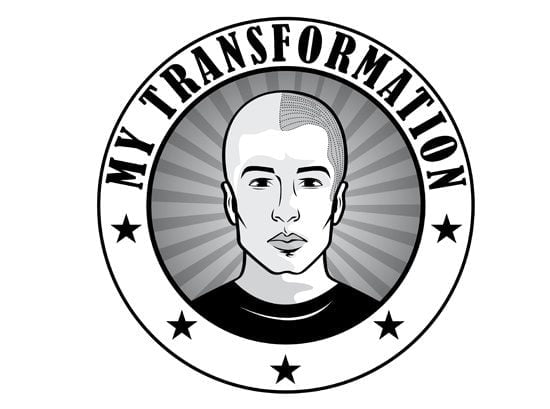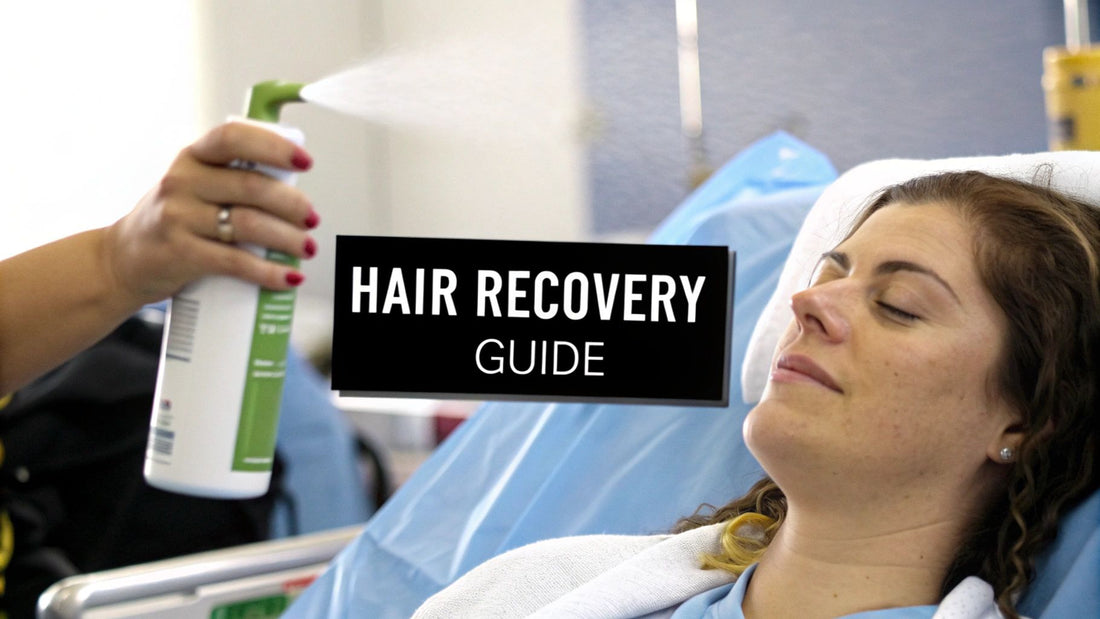
Hair Transplant Recovery A Patient's Guide
Share
Deciding to get a hair transplant is a huge step, but what you do after leaving the clinic is just as important as the procedure itself. Your hair transplant recovery is where the magic really happens, laying the groundwork for those fantastic, natural-looking results you’re after. Think of this guide as your personal road map, clearing up any confusion about what to expect day by day, week by week.
Your Hair Transplant Recovery Journey Explained
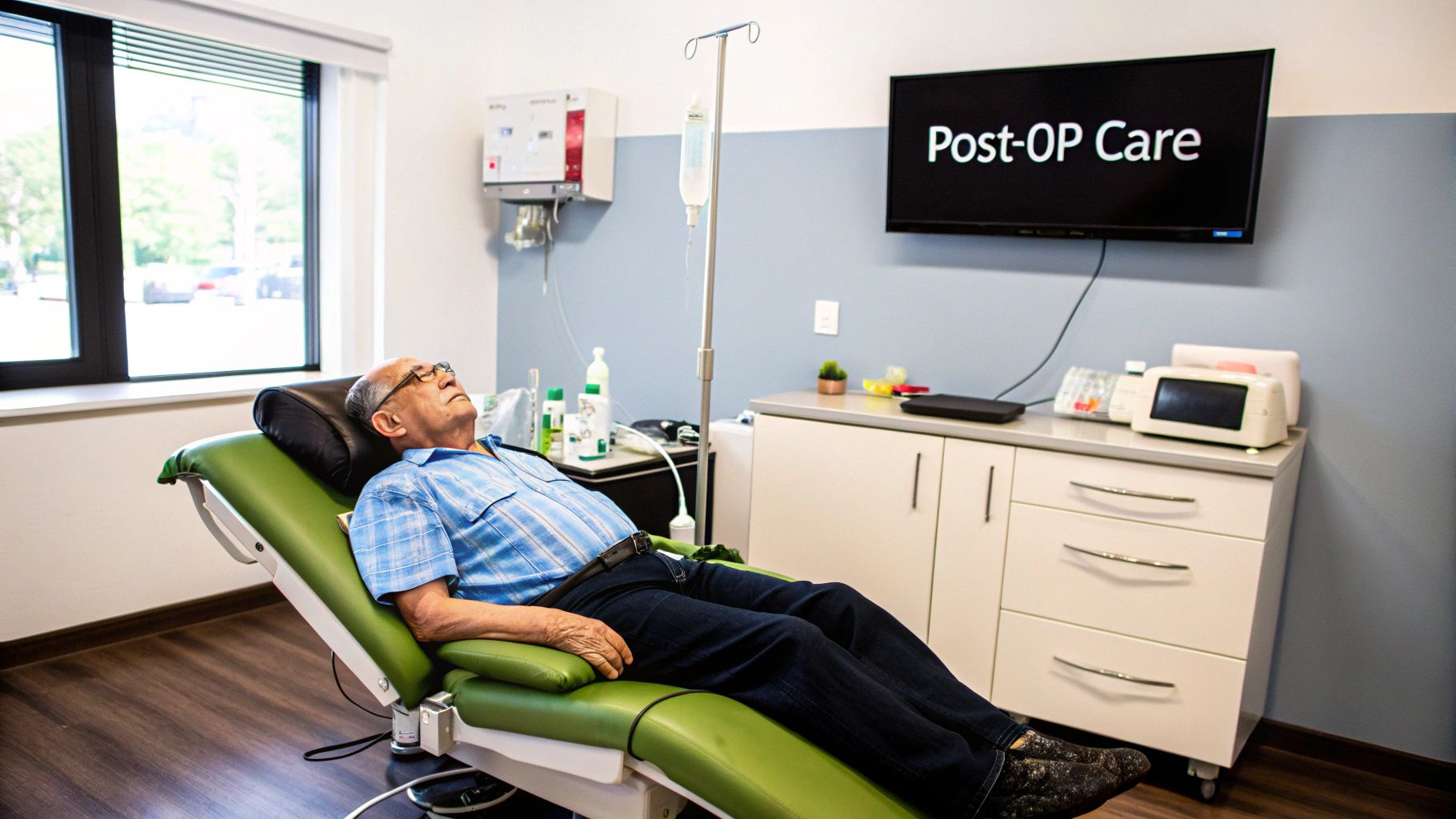
Getting a handle on the recovery timeline is crucial. It helps you manage your expectations and, most importantly, ensures you're taking the right steps to protect your new follicles. If you're still in the research phase, understanding the hair transplant procedure itself is a great place to start. But once you're on the other side, the journey breaks down into a few key phases, each with its own set of rules and milestones.
From the super-delicate first few days to seeing the final result a year later, we’ll walk you through everything.
Key Milestones in Your Recovery
Your body is pretty incredible, and the healing process follows a predictable, if sometimes slow, path. Knowing what's coming next can help you feel confident and relaxed instead of worried about every little change.
-
The First Two Weeks (Initial Healing): This is the most critical time. Your new grafts are working hard to settle in. You'll likely see some redness, a bit of swelling, and scabs forming around each graft. Be gentle!
-
Weeks 2-8 (The 'Ugly Duckling' Stage): Okay, deep breath. You're going to see some shedding. It's called "shock loss," and almost everyone goes through it. This is completely normal. The transplanted hair shafts fall out, but the precious follicles are safe and sound under the skin, just getting ready for a new cycle of growth.
-
Months 3-4 (Early Regrowth): This is when your patience starts to pay off. You'll begin to notice the first few fine, new hairs pushing through. They might look a bit like stubble at first, but it's a fantastic sign.
-
Months 5-9 (Visible Thickening): Things really start to pick up speed here. The new hairs keep growing, getting longer and thicker. You’ll see a real, noticeable improvement in your hair's density and overall coverage.
-
Months 9-12+ (The Final Result): By this point, your hair is maturing. It's reaching its final thickness and texture, blending in with the rest of your hair. This is when you can truly see the full, impressive outcome of your procedure.
Here in Australia, the timeline for a Follicular Unit Extraction (FUE) procedure is pretty consistent for most people. You can generally expect to be back at work within 2 to 5 days. The complete, mature results usually take between 9 and 12 months to fully appear. To really understand what’s happening beneath the surface, you can learn more about https://www.mytransformation.com.au/blogs/news/the-hair-growth-cycle.
Navigating The Critical First Two Weeks
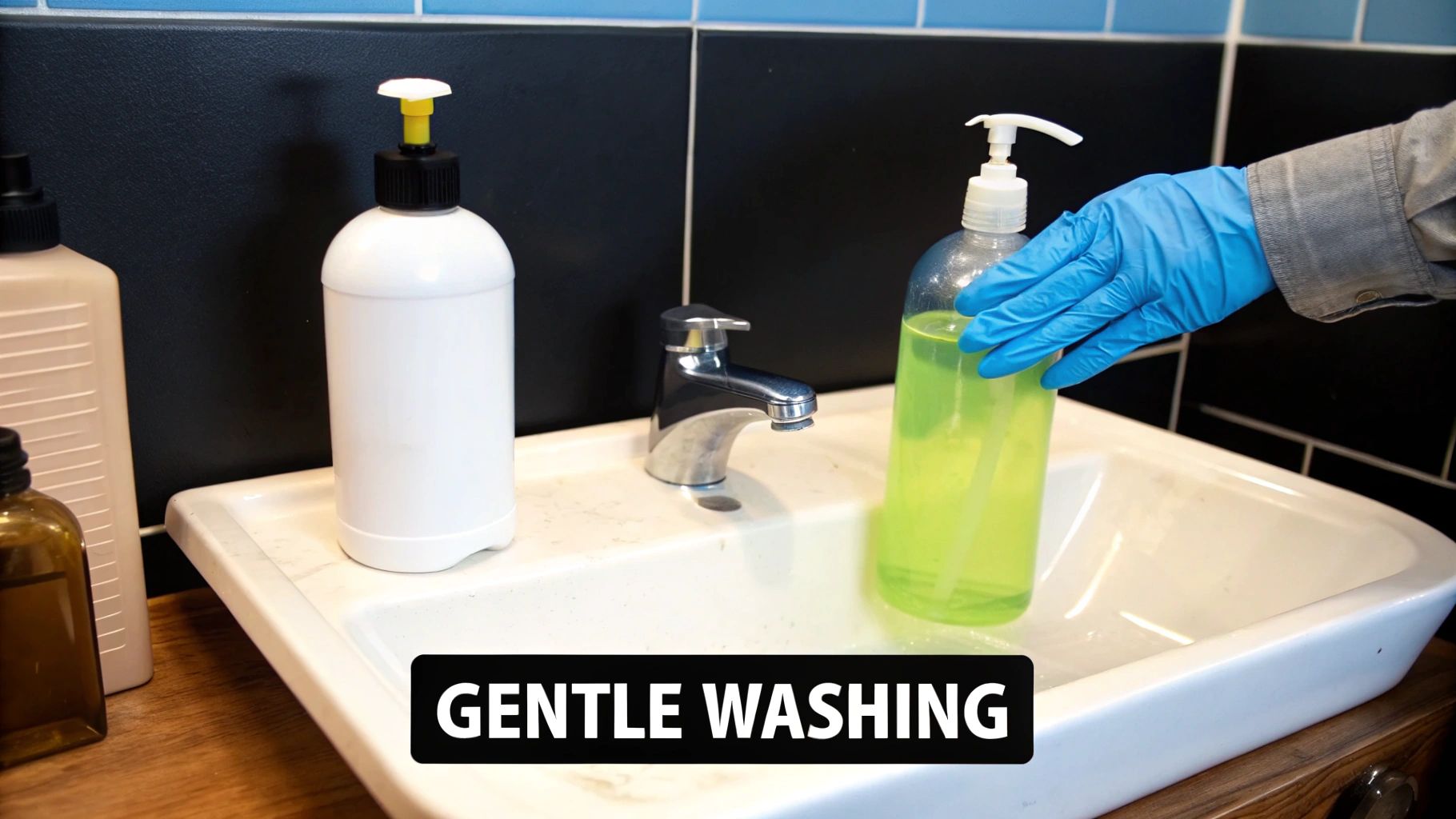
The first 14 days after your hair transplant are when everything hangs in the balance. Your new grafts are incredibly fragile, and how you treat them during this window will directly shape the final outcome of your procedure. This is, without a doubt, the most important phase of your hair transplant recovery.
Think of yourself as a guardian. Your one job is to protect these tiny new follicles while they settle in and make your scalp their permanent home. This doesn't require complicated medical routines—just a bit of mindfulness and a few simple, non-negotiable rules that give every graft the best possible chance to take hold.
Mastering Your Sleep Position
One of the first hurdles you'll face is figuring out how to sleep without accidentally sabotaging your new hair. The goal here is simple: prevent any rubbing, pressure, or contact that could dislodge those delicate grafts.
For the first 7 to 10 nights, you absolutely must sleep with your head elevated. We’re talking about a 45-degree angle. The easiest way to pull this off is to camp out in a recliner or build a fortress of pillows to prop up your upper body.
A travel pillow is an absolute game-changer here. It cradles your neck and physically stops your head from rolling onto the recipient area in the middle of the night. This elevated position isn't just about protecting the grafts; it’s also your best weapon against swelling, which usually peaks around day three or four. Gravity becomes your best friend, helping to draw fluid down and away from your scalp and forehead.
The First Hair Wash and Scalp Care
The thought of that first hair wash can be pretty nerve-wracking, I know. But it's a crucial step for keeping the area clean and helping the healing process along. Most clinics will give you the green light after 24 to 48 hours, but always, always follow your surgeon's specific timeline.
It's all about the technique. Forget everything you know about a normal, vigorous shampoo. This is more of a gentle dabbing operation.
- No Direct Water Pressure: Whatever you do, don't let the showerhead blast directly onto your scalp. Use a cup to gently pour lukewarm water over the area instead.
- Gentle Application: Your clinic will send you home with a special medicated shampoo. Don't apply it directly to your head. Lather it up in your hands first, then lightly pat the foam onto the recipient area. No rubbing, no scrubbing.
- Rinsing Carefully: Use the same pouring method to rinse. Just let the water flow over your head until the foam is gone.
- Pat, Don't Rub: To dry, you can either let it air-dry or very gently pat the area with a soft, clean towel.
Your clinic will likely provide a saline spray, and this stuff is liquid gold for the first two weeks. Use it exactly as instructed. It keeps the grafts hydrated, calms that maddening itch, and helps soften the tiny scabs that form around each follicle. If you're looking into other cosmetic scalp options, our guide on the scalp micropigmentation healing timeline might offer a useful point of comparison.
Key Takeaway: Itching is a normal, healthy sign of healing, but you must resist the urge to scratch. It's the easiest way to lose a graft. When the itchiness starts, grab your saline spray—it will provide instant relief.
Daily Life and Activities to Avoid
Protecting your investment means making some temporary tweaks to your daily life. For these first two weeks, you're in a "no-go" zone for any activity that could put your results at risk. The main things to avoid are anything that makes you sweat, raises your blood pressure, or puts physical strain on your scalp.
Here’s a practical checklist of what needs to go on hold:
- Strenuous Exercise: Stay away from the gym, running, cycling, or any heavy lifting for at least 14 days. Sweat increases the risk of infection, and a spike in blood pressure can cause bleeding at the graft sites.
- Headwear: Tight hats, beanies, and helmets are completely off-limits for 10-14 days. If you absolutely must cover your head after the first week, it has to be a very loose-fitting cap worn for short periods. Check with your clinic first.
- Direct Sun Exposure: Your scalp will be extremely sensitive. Direct sun can easily damage the healing skin and the vulnerable new follicles. If you have to be outside, keep it brief and wear that loose-fitting hat (once approved).
- Smoking and Alcohol: Both are bad news for healing because they mess with your circulation. We strongly recommend avoiding alcohol for the first week and cutting out smoking for at least two weeks—longer if you can manage it.
By getting these simple things right, you create the perfect environment for your new hair to anchor in securely and set the stage for the exciting growth phase ahead.
Mapping Your Hair Regrowth Month by Month
The time after your hair transplant is all about patience. While the initial healing phase flies by, the regrowth itself is a slow burn, a journey that really unfolds over the course of a year. If you know what to expect and when, it's so much easier to stay positive and trust the process during your hair transplant recovery.
This isn't a race to a full head of hair. Think of it more like a natural cycle with its own rhythm of shedding, sprouting, and maturing. Let’s walk through the process, month by month, so you can see what’s coming and appreciate every little milestone along the way.
The infographic below really nails the critical early stages, showing you how things progress from the initial swelling to the shedding phase that paves the way for new growth.
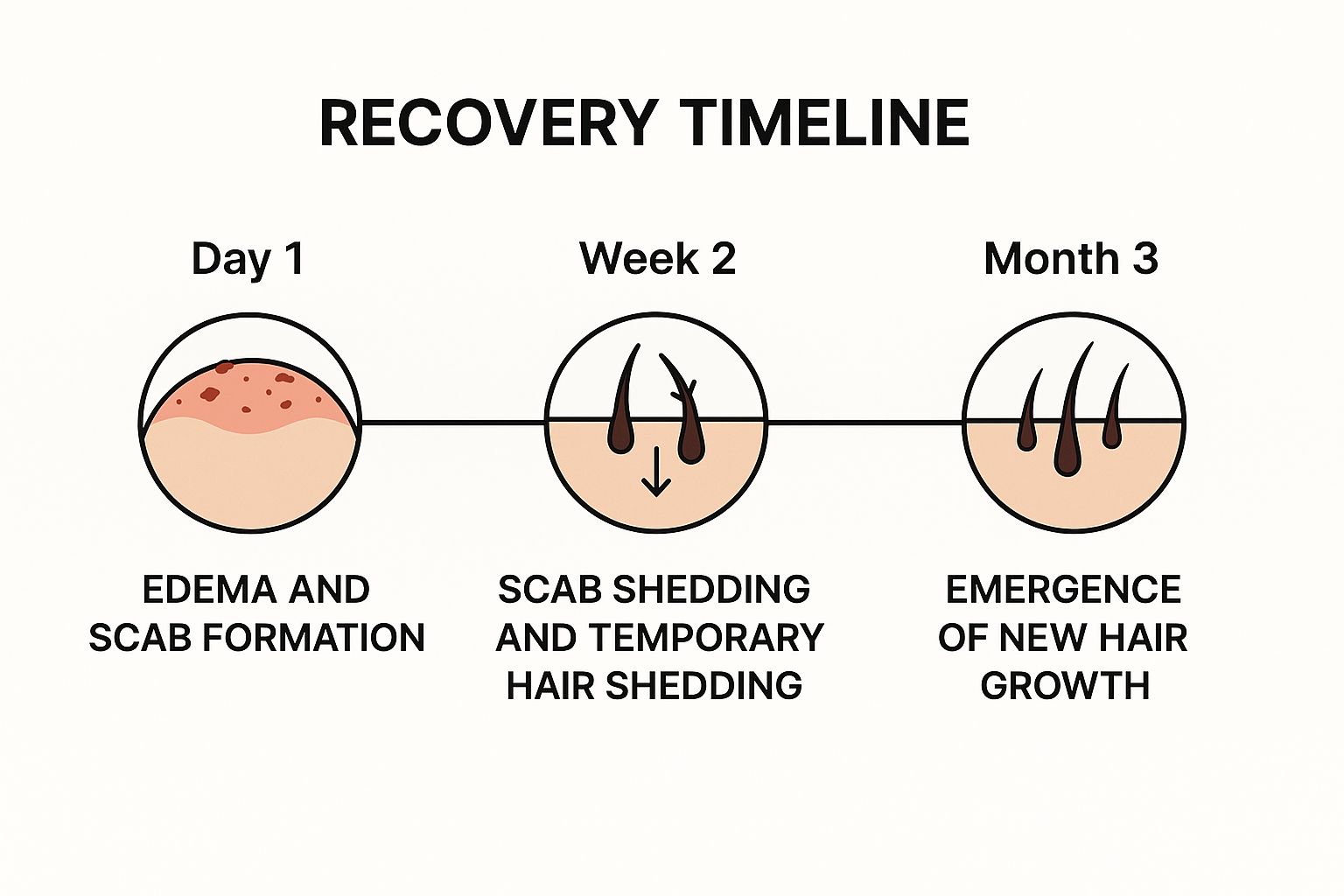
As you can see, those first few weeks are purely about healing. The hair loss you'll notice is actually a crucial, and totally normal, step before the real growth kicks in around the three-month mark.
To give you a clearer picture, here's a quick look at what the entire recovery journey looks like.
Hair Transplant Recovery Timeline At A Glance
This table breaks down the key stages, what you'll likely see and feel, and the most important aftercare actions for each phase.
| Timeframe | What to Expect (Appearance & Sensation) | Key Aftercare Actions |
|---|---|---|
| Days 1-14 | Swelling, redness, tenderness, scabbing on both donor and recipient areas. | Follow clinic’s washing protocol meticulously. Sleep elevated. Avoid touching or picking scabs. No strenuous activity. |
| Weeks 2-8 | "Shock loss" begins—transplanted hairs shed. Scalp appearance returns to pre-op look. | Continue gentle washing. You can resume light exercise as cleared by your surgeon. Be patient—this is normal. |
| Months 3-4 | First new hairs sprout, often fine, thin, and colourless. Possible pimples or "folliculitis" as hairs break through. | Be gentle with the scalp. You can start getting regular, gentle haircuts. Resist popping any pimples. |
| Months 5-6 | Noticeable new growth. Hairs begin to thicken and gain colour. Coverage starts to improve. | Start styling your hair gently. Continue a healthy diet and lifestyle to support hair growth. |
| Months 7-9 | Significant increase in density and thickness. Hair is longer, stronger, and easier to style. | Enjoy the visible transformation! Maintain a good hair care routine. |
| Months 10-18 | Final results take shape. Hair continues to mature, thicken, and blend with native hair for a natural look. | Full styling freedom. The final result is now apparent, with subtle improvements continuing for up to 18 months. |
Remember, this is a general guide. Everyone's healing and growth rate is slightly different, but this gives you a solid roadmap for the year ahead.
The First Three Months: The Waiting Game
After the initial whirlwind of aftercare, you’ll enter a quiet period often dubbed the 'ugly duckling' stage. It’s during this time, usually popping up between weeks two and eight, that you'll experience what’s known as ‘shock loss’.
It can be a bit confronting. The brand new hairs you just had transplanted will start to fall out, and it's easy to jump to the conclusion that the procedure failed. But this is a completely normal and necessary part of the cycle. The follicle itself is safe and sound under the skin; it's just shedding the hair shaft as it recovers from the trauma of being moved.
By the end of the third month, the shedding phase should be over. You might not see much action in the mirror just yet, but rest assured, your follicles are busy beneath the surface, getting ready for the main event.
Months Four to Six: The First Signs of Life
Now for the exciting part. Around the four-month mark, you'll start to spot the very first sprouts of new hair. At first, they'll likely be super fine, maybe even a bit transparent, and they can come in a little wiry or curly. Don't stress—that's just how they get started.
As you head into months five and six, these new hairs will keep coming, and you’ll notice them gradually starting to thicken up. For the first time, you'll see a real, tangible difference in coverage, even if it’s still on the thin side. This is a massive psychological boost and the first proper reward for your patience.
A Realistic Perspective: It’s easy to hope for a dramatic change overnight, but hair grows at its own pace—only about 1-1.25 cm per month. The growth you see at six months is just the start. The real thickening and maturing process will continue for many months to come.
Months Seven to Twelve: The Transformation Takes Shape
The second half of the year is where you really see the magic happen. From month seven onwards, you’ll not only see more new growth, but the quality and texture of the hair will change dramatically.
Each individual hair shaft starts to mature, getting thicker, stronger, and gaining its natural colour. This is what truly creates the look of density. The areas that seemed a bit thin at six months will look substantially fuller by the time you hit month nine. At this point, most patients report seeing around 70% of their final result.
Between months nine and twelve, you're seeing the finishing touches. Your hair will be long enough to style properly, and it will blend in seamlessly with the surrounding native hair. By the one-year mark, you should be looking at roughly 85-90% of the final outcome. For many people, especially after a Follicular Unit Extraction (FUE) procedure, the hair continues to mature and thicken for up to 18 months. It's helpful to understand the nuances of the procedure you had, and you can learn more about what an FUE hair transplant involves in our detailed guide.
Lifestyle Changes That Support Better Hair Growth

While sticking to your surgeon's aftercare plan is non-negotiable for a successful recovery, your day-to-day habits are what will truly make the results shine. The choices you make about food, fitness, and general wellness create the very environment your new hair follicles need to flourish.
I often tell my clients to think of it this way: your body is the soil, and the transplanted grafts are precious seeds. The richer and more nourished that soil is, the stronger and healthier your new hair will grow.
Once you’re past that initial healing phase, fine-tuning your lifestyle can directly influence the speed, quality, and even the final density of your new hair. These aren't just vague suggestions; they are proven strategies to get the absolute best return on your investment and secure the health of your hair for the long haul.
Fuelling Your Follicles Through Nutrition
Your hair follicles are like tiny, high-powered factories, and they need a constant supply of raw materials—vitamins and minerals—to build strong, healthy hair. A diet lacking in key nutrients can genuinely slow down your recovery and compromise the quality of the hair that grows in.
So, let's focus on what your body needs right now. You'll want to pack your diet with hair-friendly essentials.
Here’s what I recommend prioritising:
- Iron: Absolutely crucial for getting oxygen to your cells, including your follicles. Low iron (anaemia) is a classic culprit behind hair shedding. Think lean red meat, spinach, and lentils.
- Zinc: This mineral is a workhorse for hair tissue growth and repair. It also helps the oil glands around the follicles function properly. Oysters, beef, and pumpkin seeds are fantastic sources.
- Biotin (Vitamin B7): Known as the hair-health superstar for a reason, biotin is vital for producing keratin, the very protein your hair is made of. You can find it in eggs, salmon, avocados, and nuts.
- Protein: Since hair is almost entirely protein, getting enough in your diet is a must. Load up on quality sources like chicken, fish, beans, and Greek yoghurt.
A well-balanced diet does more than just support your new grafts; it strengthens your existing native hair, contributing to a fuller, healthier appearance overall. This holistic approach is one of the best ways to prevent hair loss naturally in the long run.
Reintroducing Exercise Safely
I know many of you will be eager to get back to the gym, but jumping back in too soon can spell disaster for your new grafts. For the first two weeks, all strenuous activity is off the table. The goal is to avoid sweat, spikes in blood pressure, and any physical impact on the scalp.
Once you get the green light from your surgeon, which is usually around the 14-day mark, you can start easing back into a routine. Begin with low-impact activities like a brisk walk or some light cycling. You’ll want to avoid anything that puts direct pressure on your scalp, so yoga headstands are out for now. From there, you can gradually ramp up the intensity over the following weeks, but always listen to your body and follow your clinic's specific guidance.
Making Healthier Choices for Better Healing
Some habits can actively work against your body's healing process by messing with circulation to the scalp. There's no better time than now to get them sorted.
Smoking and Alcohol
Both of these are bad news for healing. Smoking and excessive alcohol constrict your blood vessels, which chokes off the supply of oxygen and nutrients to your brand-new follicles. This can seriously harm graft survival and drag out your recovery. Making a real change, like looking into effective quit smoking tips, can make a massive difference. You should aim to avoid alcohol completely for at least the first week and quit smoking for as long as you possibly can—ideally for good.
Sun Protection
After your procedure, your scalp is going to be incredibly sensitive and vulnerable. The recipient area, in particular, can be easily damaged by the sun. The harsh Australian sun can burn this delicate new skin in a heartbeat, which could potentially damage the follicles underneath.
For the first few months, sun protection is mandatory. Wear a loose-fitting hat anytime you're outside for more than a few minutes. Once your scalp is fully healed, you can look into a high-SPF sunscreen made specifically for the scalp. By building these positive habits, you’re not just recovering from a procedure; you're actively taking control and ensuring a much more successful outcome.
Spotting and Managing Potential Complications
Let's be clear: modern hair transplants are incredibly safe, and serious complications are very rare. The success rate here in Australia is fantastic, with well-performed Follicular Unit Extraction (FUE) procedures boasting graft survival rates between 85% and 95%. These numbers aren't just statistics; they're a testament to the skill of Australian surgeons and, just as importantly, great patient aftercare. You can read a bit more about these high success rates in Australia.
Still, knowing what’s normal and what’s not during your recovery is the key to your peace of mind. Your body is healing, and it will give you plenty of signals. The real goal is to learn how to read them correctly, so you can relax through the standard stages and act fast if something doesn’t feel right.
What Normal Healing Looks and Feels Like
First off, let’s set a baseline for what a healthy recovery actually involves. Knowing what to expect will stop you from second-guessing every little thing.
- Mild Swelling and Redness: It’s completely normal to see some swelling around your forehead and even your eyes. This usually peaks around day three and then starts to go down. Your scalp will also look pinkish or red, but this colour will slowly fade over the next week or two.
- Scabbing and Itching: You'll see tiny scabs form around each new follicle. Think of these as nature’s little plasters, protecting the delicate grafts. Itching almost always comes with it, and while annoying, it’s a great sign that your skin is healing. Just don’t scratch!
- A Bit of Discomfort: Expect a feeling of tightness or mild tenderness where the work was done. This is standard stuff and easily managed with the pain relief your clinic provides.
These are all positive signs. They mean your body is doing exactly what it’s supposed to: anchoring those new grafts and repairing the skin.
Red Flags That Need a Phone Call
While the vast majority of recoveries go off without a hitch, it pays to be vigilant. There are a few warning signs that go beyond normal healing and mean you should call your surgeon straight away. Don't adopt a "wait and see" attitude here; getting on top of things quickly is vital.
Your clinic is your partner in this. They genuinely want to hear from you if you have any concerns at all. Never hesitate to make that call—it's always better to get professional reassurance and be safe.
Keep an eye out for these specific issues:
- Swelling That’s Excessive or Lingers: If the swelling is severe, genuinely painful, or isn't starting to improve after day four, it's time to get it checked.
- Pain That’s More Than Just 'Discomfort': The mild tenderness we talked about is one thing. But pain that is intense, throbbing, or isn’t touched by your prescribed medication is a definite red flag.
- Signs of Infection: Be on high alert for any yellowish or greenish discharge (pus) from the scalp, a bad smell, or if you develop a fever. Redness that seems to be spreading or darkening instead of fading is another tell-tale sign.
- Bleeding That Won't Stop: A tiny bit of spotting in the first 24 hours is no big deal. However, any bleeding that continues and doesn't stop with a bit of gentle pressure needs immediate attention.
- Large, Painful Pimples: Small pimples (folliculitis) can pop up as new hairs push through, and that's usually fine. But if you see large, inflamed, painful cysts, it could signal a deeper issue like an ingrown hair that needs looking at.
If scarring is a particular worry for you, especially in the donor area, it's worth reading our detailed guide on managing and minimising hair transplant scars. It gives you a much better understanding of how that specific healing process works.
By knowing what to expect, you can navigate your recovery with confidence. Most of what you'll experience will be perfectly normal, but being able to spot potential trouble early ensures you protect both your health and your investment.
Answering Your Top Hair Transplant Recovery Questions
Even with a detailed recovery plan in your hands, you're bound to have questions pop up. It's only natural to wonder about the little things – the day-to-day details of life as you heal. Getting clear answers not only provides peace of mind but also ensures you don't accidentally do something that could jeopardise your fantastic new results.
We've been there and heard it all. So, we've compiled the most common questions we get from patients, with direct, practical answers to help you feel confident and in control.
When Can I Wear a Hat or Use Styling Products Again?
This is a big one. Protecting your new grafts from any sort of friction or pressure is absolutely non-negotiable in the first week or so. You'll need to avoid any kind of hat, beanie, or helmet for at least 7 to 10 days after your procedure. It might seem overly cautious, but wearing head wear too soon can physically dislodge those delicate, newly implanted follicles before they’ve had a chance to properly anchor in.
Once you’ve passed that initial window, you can typically start wearing a very loose-fitting cap for short periods. But it's always smart to get the green light from your clinic first.
As for styling products like gels, waxes, or sprays, you’ll need to be even more patient. Hold off until your scalp is completely healed – that means waiting until all the scabs have come away naturally and the skin is no longer red or tender. This usually takes about 3 to 4 weeks. Introducing sticky products and chemicals too early can easily clog the follicles and seriously increase your risk of irritation or even infection.
Is It Normal for My Scalp to Feel Numb?
Yes, absolutely. A feeling of numbness or tingling is an extremely common, and completely expected, part of the healing journey. You might notice it in the recipient area where the new hairs were placed, the donor area at the back of your head, or both. It all comes down to the tiny nerve endings just under the skin’s surface, which get temporarily disrupted during the procedure.
Don't worry, this loss of sensation isn't permanent. Your body gets to work repairing these nerve connections, and you'll find that feeling gradually returns over the following weeks and months. For most people, normal sensation is fully back within 3 to 6 months. While the feeling can be a bit odd, it’s a standard sign of healing. That said, if the numbness is paired with severe or worsening pain, you should get in touch with your clinic right away.
An Expert's Take: I often tell my patients to think of it like the numbness you get after a dental filling. The area is temporarily desensitised while all the important healing happens underneath. Patience is the key here, as nerves simply regenerate at their own pace.
How Can I Speed Up My Recovery and Hair Growth?
Ah, the million-dollar question! The honest answer is that you can't really change the fundamental biological timeline of hair growth. Your follicles have their own predetermined schedule for cycling through their resting and growing phases. What you can do, however, is create the absolute best environment for them to thrive.
The single most important thing for a successful outcome is following your surgeon's aftercare instructions down to the last detail. Beyond that, your lifestyle choices play a massive supporting role.
- Fuel Your Follicles: A balanced diet loaded with protein, iron, zinc, and B-vitamins gives your hair the essential building blocks it needs to grow strong.
- Drink Up: Staying well-hydrated is crucial for good cell function and healing all over your body, and that includes your scalp.
- Ditch the Vices: Smoking and heavy alcohol consumption can both mess with your circulation, slowing down the flow of oxygen and nutrients to your healing follicles.
- Chill Out: High stress levels can have a real, negative impact on hair growth cycles. Finding healthy ways to manage stress is genuinely good for your results.
Some clinics might also recommend supplementary treatments like Platelet-Rich Plasma (PRP) therapy to give things a boost. Always have a chat with your surgeon about these options first to make sure they’re right for you.
What Is "Shock Loss" and Should I Be Worried?
Seeing your newly transplanted hair start to fall out can be pretty confronting, but try not to panic. This is "shock loss," and it’s a temporary shedding of transplanted hairs (and sometimes a few neighbouring native hairs) that typically happens between 2 and 8 weeks post-op. It’s a completely normal, expected, and temporary part of the process.
Here’s what’s actually going on: the physical act of transplanting the follicles puts them through a bit of trauma, which essentially pushes them into a resting (telogen) phase. When this happens, the hair shaft is released and falls out.
The crucial thing to remember is that only the hair falls out—the precious follicle remains safely anchored under the skin. This shedding is just making way for a brand-new, stronger hair to start its growth cycle. You'll start to see new, permanent hair sprouting from these follicles at around the 3 to 4-month mark. So, while it’s a frustrating phase to go through, shock loss is actually a sign that everything is moving along just as it should be. It's a temporary dip on the road to your final, fantastic result.
At My Transformation, we are dedicated to helping you achieve a hair loss solution that restores your confidence. Michael's passion and expertise in Scalp Micropigmentation (SMP) provide a world-class alternative and complementary treatment for hair density issues.
Ready to explore your options? Learn more about our life-changing services.
